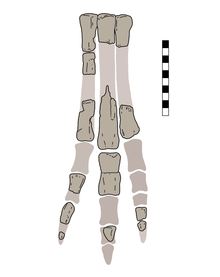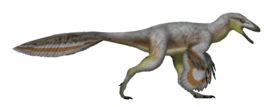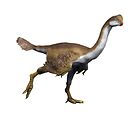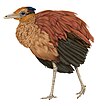強戰龍屬
| 強戰龍屬 | |
|---|---|

| |
| 左後肢重建圖 | |
| 科學分類 | |
| 界: | 動物界 Animalia |
| 門: | 脊索動物門 Chordata |
| 綱: | 蜥形綱 Sauropsida |
| 總目: | 恐龍總目 Dinosauria |
| 目: | 蜥臀目 Saurischia |
| 亞目: | 獸腳亞目 Theropoda |
| 演化支: | 廓羽盜龍類 Pennaraptora |
| 演化支: | 近鳥類 Paraves |
| 屬: | †強戰龍屬 Imperobator Ely & Case, 2019 |
| 模式種 | |
| †南極強戰龍 Imperobator antarcticus Ely & Case, 2019
| |
強戰龍屬(學名:Imperobator,意為「強大的戰士」)是近鳥型獸腳類恐龍的一個屬,生存於晚白堊世馬斯垂克期的南極詹姆斯羅斯島。強戰龍是南極僅發現的兩種非鳥獸腳類之一,是在南極仍為岡瓦納古陸的一部分時遷徒至此。唯一被描述的標本由加州大學古生物學博物館派出的考察隊於2003年發現,最初在2007年被描述為一種馳龍科。然而,後期研究報道了來自同一地點的更多化石,包括牙齒及腦顱骨骼。這些化石於2019年被描述為大型近鳥類新屬。
強戰龍是已知最大的近鳥類之一,估計高約2公尺(6英尺7英寸),體型和猶他盜龍等大型馳龍科相仿。由於第二趾缺少馳龍科特有的「鐮刀爪」,強戰龍被暫時分類為親緣關係不明的原始近鳥類。
強戰龍發現於雪丘島組蘭布角段,該地層亦出產各類其它物種的化石,其中許多都是在岡瓦納古陸解體後自南極孤立進化而來,因此非常獨特。與強戰龍共存的生物包括鳥腳類恐龍莫羅龍和鳥類的南極鳥以及眾多滄龍、蛇頸龍及翼龍。
發現與命名
[編輯]
2003年,加州大學古生物學博物館遣往南極詹姆斯羅斯島內茲半島尋找化石的考察隊發現一隻大型獸腳類恐龍的化石。[1][2][3]該半島有幾處海相沉積的含化石露頭,此處則隸屬雪丘島組蘭布角段(Cape Lamb Member),地層年代可追溯至早白堊世馬斯垂克期(約7100萬年前)。[4][2]該化石主要由不完整的孤立左腳組成,包括部分脛骨、一個不完整的距骨、部分跟骨與腓骨、爪骨、部分趾骨及跖骨,此外還發現了牙齒。[1][2]標本後保存於加州大學古生物學博物館,並被賦予編號UCMP 276000。東華盛頓大學和南達科他礦業及理工學院亦陳列著屬於UCMP 276000的其它化石,包括可能來自前頜骨、上頜骨和/或齒骨的顱骨碎片及一節尾椎、更多牙齒與腳部材料。[4]第三次南極半島古生物計劃(Antarctic Peninsula Paleontology Project)的探險隊先後於2011和2016年在同一地點發現更多屬於UCMP 276000個體的化石,如牙齒、不完整的腳爪骨、顱骨碎片及其它不明骨髂碎片,現以編號AMNH FARB 30894保存於美國自然歷史博物館。[4][5][6]拉曼納等人(2019年)稱現已開始撰寫對新遺骸的描述。[4]
2005年發表的文獻首次報道這些化石,作者認為該標本是「原岡瓦納古陸恐龍動物群的原始殘存物種」,並指出其衍生特徵少於馬斯垂克期的其它馳龍科。[3][6]2007年發表一篇對該獸腳類標本的較詳細描述,其中認為此標本屬於馳龍科,並按發現地點稱之為「內茲馳龍」("Naze dromaeosaur")。[1][7]化石屬於馳龍科的觀點並不正確,因為其腳部缺少獨特的鐮刀爪及該科其它特徵。[2][1]此標本由美國古生物學家里卡多·伊利(Ricardo Ely)和賈德·凱斯(Judd Case)於2019年正式描述為新屬新種南極強戰龍(Imperobator antarcticus)的正模標本。屬名源自拉丁語,意為「強大的戰士」,種名則指發現標本的大陸。[2]
描述
[編輯]正模標本長約45公分(1英尺6英寸)。估計強戰龍高2公尺(6英尺7英寸),[2]體型和已命名的最大馳龍科——猶他盜龍近似。[8]這表明強戰龍患有巨人症,該特徵在近鳥類中並不常見,在猶他盜龍、南方盜龍、恐爪龍及達科他盜龍身上表現得最為明顯。儘管曾被歸入馳龍科,但其某些特徵與後者不同,包括缺少鐮刀爪、第二跖骨遠端表面光滑及第二指沒有爪骨,故被歸入近鳥類[2]標本還保存了來自上頜及齒骨的牙齒,這些牙齒長而彎且鋒利,類似其它肉食性近鳥類。[6][4]
腿部
[編輯]Imperobator is known only from fragmentary remains of the hindlimb, but it is still unique in several ways. The distal portion of the left tibia (shin bone) and some of the astragalus are preserved, though much of their characteristic features are missing due to erosion and frost. Both calcanea are preserved and are fused with the fibulae, a unique trait of the genus, with a fossa (shallow depression) on the internal surface of the calcanea for articulation with the astragalus. The calcanea have a circular, smooth surface divided by a groove running along its dorsal side. The left tarsal is longer anteroposteriorly than it is wide with a sub-triangular outline in anterior view.[2][1]
The metatarsals are preserved but are fragmented and broken. Of the ones preserved, metatarsals II and IV are broken into three pieces and metatarsal III into two pieces. Metatarsal V may be preserved, but it is not definitively stated by Ely & Case (2019). Metatarsal II is unique from that of other paravians in that it is parallelogram-shaped in cross-section, contrary to the circular or ovate forms in other genera. It also may preserve another diagnostic trait, a medial slant at the end of the diaphysis (midsection of the long bone), though this could be a pathological trait. Metatarsal III is heavily damaged but shows a symmetrical distal articular end and a triangle-shaped proximal end in anterior view, as in other paravians. The fourth metatarsal has a long ridge running along its posterior edge with a wider proximal end proportionally compared to the other metatarsals. The second pedal digit is incomplete, but a proximal half of phalanx II and the ungual is known from it. The third is represented by a proximal phalanx fragment, which is poorly preserved. A complete proximal-most phalanx of the fourth digit was also found. The incomplete ungual has a prominent flexor heel, a trait shared by the Romanian paravian Balaur bondoc.[2][9]
分類
[編輯]
本屬正式描述之前,2007年發表的一篇論文將標本歸入馳龍科,並取了「內茲馳龍」的暱稱。[1]該結論存在問題,因為UCMP 276000缺乏多項馳龍科特徵,包括鋒利的鐮刀爪,命名、描述強戰龍的論文也僅將其歸入近鳥類。[2]正式描述中,作者將該分類單元恢復為一種近鳥型獸腳類,與該類群的較小成員近緣:[2]
| 近鳥類 Paraves |
| ||||||||||||||||||||||||||||||
同年,斯科特·哈特曼(Scott Hartman)等人在西鳥龍描述中進行一項關於獸腳類的大規模系統發育分析,其中將強戰龍(當時尚未命名)恢復成一種與恐手龍科近緣的原始似鳥龍類。[10]然而,作者之一所做的該分析更新版本,則將其恢復為處於馳龍科、半鳥亞科及傷齒龍科之外的恐爪龍下目原始成員。[6]2024年,掠鳥龍描述者提出強戰龍可能屬於半鳥亞科。[11]
古環境
[編輯]
Imperobator is known solely from the Cape Lamb Member of the Snow Hill Island Formation in James Ross Island, an island in the James Ross Island group on the northeastern edge of the Antarctic Peninsula. The Snow Hill Island Formation is one of only two major dinosaur-bearing rock formations found on Antarctica, bearing all but two of the continent's named dinosaurs.[12] The floral composition, habitat, and climate are of one similar to modern volcanic arches.[13] During the time in which Imperobator lived, Earth's climate was much warmer and more humid than it is today and as a result Antarctica was without ice. The environment was mainly dominated by large dense conifer forests, cycads, and ginkgos. The animals inhabiting Antarctica at this time would still have had to endure long periods of darkness during the winter, much like in modern-day Antarctica.[4]
Imperobator's fossils bear some surface weathering and abrasion, which indicate that they have gone through minimal transport, reworking, and sub-aerial weathering.[2] This is in contrast to the holotype of the ankylosaur Antarctopelta, which likely floated out to sea and was buried by marine sediments on the ocean floor.[14][15] From the site in which Imperobator was found, pollen grains from Asteraceae, the group containing sunflowers and daisies, are the oldest records of the family that were collected.[16] Some of the environment may have been wet and similar to peat bogs, as evidenced by Sphagnaceae (peat mosses) and several other groups like the clubmoss Selaginella, the firmoss group Lycopodiaceae, and the clade Ericaceae.[17] The Cape Lamb Member of the formation has yielded several other fossil remains, such as the herbivorous ornithopod Morrosaurus, an indeterminate hypsilophodontid ornithopod,[13] the avian Antarcticavis,[18] an indeterminate neornithine,[19] an unnamed pterosaur,[20] the elasmosaurid Vegasaurus;[21] the mosasaurs Taniwhasaurus,[22] Liodon,[23] Plioplatecarpus,[22] and Mosasaurus,[23] sharks such as Notidanodon,[13] and several bony fishes from the groups Teleostei,[13] Actinopterygii,[24] Ichthyodectiformes,[13] and Sphenocephalidae.[13] Shelled ammonites, a kind of aquatic, shelled cephalopod, are found in the layers of the Cape Lamb Member.[13]
參考資料
[編輯]- ^ 1.0 1.1 1.2 1.3 1.4 1.5 Case, J. A.; Martin, J. E.; Reguero, M. A dromaeosaur from the Maastrichtian of James Ross Island and the Late Cretaceous Antarctic dinosaur fauna. U.S. Geological Survey and the National Academies. Open-File Report. 2007: 1−4. doi:10.3133/ofr20071047SRP083
 .
.
- ^ 2.00 2.01 2.02 2.03 2.04 2.05 2.06 2.07 2.08 2.09 2.10 2.11 Ely, R. C.; Case, J. A. Phylogeny of A New Gigantic Paravian (Theropoda; Coelurosauria; Maniraptora) From The Upper Cretaceous Of James Ross Island, Antarctica. Cretaceous Research. 2019, 101: 1–16. S2CID 146325060. doi:10.1016/j.cretres.2019.04.003
 (英語).
(英語).
- ^ 3.0 3.1 Martin, James; Case, Judd. Fossil hunting in Antarctica.. Geotimes Magazine. 2005: 18–21.
- ^ 4.0 4.1 4.2 4.3 4.4 4.5 Lamanna, Matthew; Case, Judd; Roberts, Eric; Arbour, Victoria. Late Cretaceous non-avian dinosaurs from the James Ross Basin, Antarctica: description of new material, updated synthesis, biostratigraphy, and paleobiogeography. Advances in Polar Science. 2019, 30 (3): 228–250.
- ^ Lamanna, O'Connor, Salisbury, Gorscak, Clarke, MacPhee, Roberts, Malinzak, Ely and Case, (2017). New material of non-avian dinosaurs from the Late Cretaceous of James Ross Island, Antarctica. Journal of Vertebrate Paleontology. Program and Abstracts 2017, 147.
- ^ 6.0 6.1 6.2 6.3 Mortimer, Mickey. Troodontidae. The Theropoda Database. [2023-05-26]. (原始內容存檔於5 Jan 2023).
- ^ Reguero, Marcelo A.; Tambussi, Claudia P.; Coria, Rodolfo A.; Marenssi, Sergio A. Late Cretaceous dinosaurs from the James Ross Basin, West Antarctica. Geological Society, London, Special Publications. 2013, 381 (1): 99–116. ISSN 0305-8719. S2CID 130027429. doi:10.1144/SP381.20. hdl:11336/183603
 (英語).
(英語).
- ^ Erickson, Gregory M.; Rauhut, Oliver W. M.; Zhou, Zhonghe; Turner, Alan H.; Inouye, Brian D.; Hu, Dongyu; Norell, Mark A. Was Dinosaurian Physiology Inherited by Birds? Reconciling Slow Growth in Archaeopteryx. PLOS ONE. 2009, 4 (10): e7390. ISSN 1932-6203. PMC 2756958
 . PMID 19816582. doi:10.1371/journal.pone.0007390
. PMID 19816582. doi:10.1371/journal.pone.0007390  (英語).
(英語).
- ^ Brusatte, Stephen L.; Vremir, Mátyás; Csiki-Sava, Zoltán; Turner, Alan H.; Watanabe, Akinobu; Erickson, Gregory M.; Norell, Mark A. The Osteology of Balaur bondoc, an Island-Dwelling Dromaeosaurid (Dinosauria: Theropoda) from the Late Cretaceous of Romania. Bulletin of the American Museum of Natural History. 2013-02-13, 374: 1–100. ISSN 0003-0090. S2CID 59932467. doi:10.1206/798.1 (英語).
- ^ Hartman, S.; Mortimer, M.; Wahl, W. R.; Lomax, D. R.; Lippincott, J.; Lovelace, D. M. A new paravian dinosaur from the Late Jurassic of North America supports a late acquisition of avian flight. PeerJ. 2019, 7: e7247. PMC 6626525
 . PMID 31333906. doi:10.7717/peerj.7247
. PMID 31333906. doi:10.7717/peerj.7247  .
.
- ^ Porfiri, Juan D.; Baiano, Mattia A.; dos Santos, Domenica D.; Gianechini, Federico A.; Pittman, Michael; Lamanna, Matthew C. Diuqin lechiguanae gen. et sp. nov., a new unenlagiine (Theropoda: Paraves) from the Bajo de la Carpa Formation (Neuquén Group, Upper Cretaceous) of Neuquén Province, Patagonia, Argentina. BMC Ecology and Evolution. 2024-06-14, 24 (1). ISSN 2730-7182. PMC 11177497
 . PMID 38872101. doi:10.1186/s12862-024-02247-w
. PMID 38872101. doi:10.1186/s12862-024-02247-w  (英語).
(英語).
- ^ Smith, N. D., Makovicky, P. J., Pol, D., Hammer, W. R., & Currie, P. J. (2007). The dinosaurs of the Early Jurassic Hanson Formation of the central Transantarctic Mountains: phylogenetic review and synthesis. US Geological Survey and the National Academies, Short Research Paper, 3.
- ^ 13.0 13.1 13.2 13.3 13.4 13.5 13.6 Reguero, Marcelo A.; Gasparini, Zulma; Olivero, Eduardo B.; Coria, Rodolfo A.; Fernández, Marta S.; O´gorman, José P.; Gouiric-Cavalli, Soledad; Hospitaleche, Carolina Acosta; Bona, Paula; Iglesias, Ari; Gelfo, Javier N.; Raffi, María E.; Moly, Juan José; Santillana, Sergio N.; Cárdenas, Magalí. Late Campanian-Early Maastrichtian Vertebrates From The James Ross Basin, West Antarctica: Updated Synthesis, Biostratigraphy, And Paleobiogeography. Anais da Academia Brasileira de Ciências. 2022-06-03, 94: e20211142. ISSN 0001-3765. PMID 35674550. S2CID 249359371. doi:10.1590/0001-3765202220211142 (英語).
- ^ Mallon, Jordan C.; Henderson, Donald M.; McDonough, Colleen M.; Loughry, W.J. A "bloat-and-float" taphonomic model best explains the upside-down preservation of ankylosaurs. Palaeogeography, Palaeoclimatology, Palaeoecology. 2018, 497: 117–127. doi:10.1016/j.palaeo.2018.02.010
 (英語).
(英語).
- ^ Salgado, L.; Gasparini, Z. Reappraisal of an ankylosaurian dinosaur from the Upper Cretaceous of James Ross Island (Antarctica). (PDF). Geodiversitas. 2006, 28 (1): 119–135. (原始內容存檔 (PDF)於2023-05-21).
- ^ Barreda, Viviana D.; Palazzesi, Luis; Tellería, Maria C.; Olivero, Eduardo B.; Raine, J. Ian; Forest, Félix. Early evolution of the angiosperm clade Asteraceae in the Cretaceous of Antarctica. Proceedings of the National Academy of Sciences. 2015, 112 (35): 10989–10994. ISSN 0027-8424. PMC 4568267
 . PMID 26261324. doi:10.1073/pnas.1423653112
. PMID 26261324. doi:10.1073/pnas.1423653112  (英語).
(英語).
- ^ Barreda, Viviana D.; Palazzesi, Luis; Olivero, Eduardo B. When flowering plants ruled Antarctica: evidence from Cretaceous pollen grains. New Phytologist. 2019, 223 (2): 1023–1030. ISSN 0028-646X. PMID 30924945. doi:10.1111/nph.15823. hdl:11336/120926
 (英語).
(英語).
- ^ Cordes-Person, Amanda; Acosta Hospitaleche, Carolina; Case, Judd; Martin, James. An enigmatic bird from the lower Maastrichtian of Vega Island, Antarctica. Cretaceous Research. 2020-04-01, 108: 104314. ISSN 0195-6671. S2CID 213442204. doi:10.1016/j.cretres.2019.104314
 (英語).
(英語).
- ^ Acosta Hospitaleche, Carolina; Gelfo, Javier N. New Antarctic findings of Upper Cretaceous and lower Eocene loons (Aves: Gaviiformes). Annales de Paléontologie. 2015, 101 (4): 315–324. doi:10.1016/j.annpal.2015.10.002. hdl:11336/53690
 (英語).
(英語).
- ^ Kellner, Alexander W. A.; Rodrigues, Taissa; Costa, Fabiana R.; Weinschütz, Luiz C.; Figueiredo, Rodrigo G.; Souza, Geovane a. De; Brum, Arthur S.; Eleutério, Lúcia H. S.; Mueller, Carsten W.; Sayão, Juliana M. Pterodactyloid pterosaur bones from Cretaceous deposits of the Antarctic Peninsula. Anais da Academia Brasileira de Ciências. 2019-12-02, 91 (suppl 2): e20191300. ISSN 0001-3765. PMID 31800676. S2CID 208642733. doi:10.1590/0001-3765201920191300
 (英語).
(英語).
- ^ O』Gorman, José P.; Salgado, Leonardo; Olivero, Eduardo B.; Marenssi, Sergio A. Vegasaurus molyi, gen. et sp. nov. (Plesiosauria, Elasmosauridae), from the Cape Lamb Member (lower maastrichtian) of the Snow Hill Island Formation, Vega Island, Antarctica, and remarks on Wedellian Elasmosauridae. Journal of Vertebrate Paleontology. 2015-05-04, 35 (3): e931285. ISSN 0272-4634. S2CID 128965534. doi:10.1080/02724634.2014.931285. hdl:11336/53416
 (英語).
(英語).
- ^ 22.0 22.1 Martin S. Fernandez; Zulma Gasparini. Campanian and Maastrichtian mosasaurs from Antarctic Peninsula and Patagonia, Argentina. Bulletin de la Société Géologique de France. 2012, 183 (2): 93–102. S2CID 129228056. doi:10.2113/gssgfbull.183.2.93.
- ^ 23.0 23.1 Martin, J. E., Bell Jr, G. L., Case, J. A., Chaney, D. S., Fernández, M. A., Gasparini, Z., ... & Woodburne, M. O. (2002). Mosasaurs (Reptilia) from the Late Cretaceous of the Antarctic peninsula. In Antarctica at the Close of a Millennium, Eighth International Symposium on Antarctic Earth Sciences. Royal Society, New Zealand Bulletin (Vol. 35, pp. 293-299).
- ^ Roberts, Eric M.; Lamanna, Matthew C.; Clarke, Julia A.; Meng, Jin; Gorscak, Eric; Sertich, Joseph J. W.; O'Connor, Patrick M.; Claeson, Kerin M.; MacPhee, Ross D. E. Stratigraphy and vertebrate paleoecology of Upper Cretaceous–?lowest Paleogene strata on Vega Island, Antarctica. Palaeogeography, Palaeoclimatology, Palaeoecology. 2014-05-15, 402: 55–72. ISSN 0031-0182. doi:10.1016/j.palaeo.2014.03.005 (英語).























